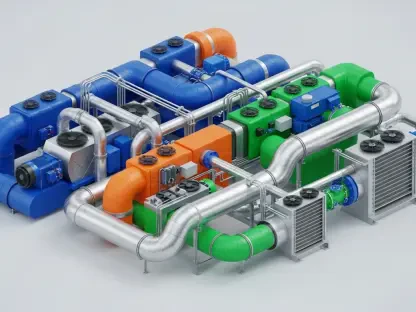In a startling incident that has once again cast a spotlight on workplace safety, a chemical spill at LG Energy Solution in Holland, Michigan, has sent fifteen individuals to local hospitals for evaluation and treatment. This event, which occurred at the facility on E. 48th Street on September 6, prompted an immediate response from the Holland Department of Public Safety. Hazardous materials protocols were swiftly enacted to secure the area, and thankfully, the spill was contained on-site with no reported threat to the surrounding community. However, the lack of detailed information regarding the specific chemical involved or the volume spilled leaves lingering questions about the severity and potential long-term impacts of the incident. This alarming situation serves as a stark reminder of the inherent risks faced by workers in industrial environments handling hazardous substances, setting the stage for a deeper examination of safety practices at the facility.
A Troubling Pattern of Incidents
The recent chemical spill at LG Energy Solution is not an isolated event but rather part of a disturbing trend of safety issues at the Holland facility. Less than two months prior to this incident, a tragic machinery accident claimed the life of a 34-year-old contractor named Kim Jong Won, who was working for LG PRI. While installing equipment, an unexpected activation led to fatal injuries despite the contractor wearing a safety helmet. Emergency responders arrived to find him deceased, with no opportunity for lifesaving measures. LG issued a statement expressing condolences and temporarily halted equipment setup in the affected area, underscoring their commitment to safety. Yet, the recurrence of such grave incidents raises critical questions about the effectiveness of existing protocols and whether enough is being done to protect workers from preventable harm in high-risk environments.
Delving deeper into the facility’s history reveals a pattern of safety lapses spanning nearly a decade. Records from the Holland Department of Public Safety, obtained through the Freedom of Information Act, indicate four other incidents since operations began that have faced scrutiny. Additionally, data from the Michigan Occupational Safety and Health Administration (MIOSHA) documents 24 cases since 2017, highlighting a consistent failure to maintain a safe working environment. In April of last year, LG received seven citations following a fatal incident, including two “willful” violations for neglecting lockout/tagout procedures—each carrying a hefty $70,000 penalty. These violations, deemed the most serious by OSHA, suggest a troubling disregard for employee safety. The remaining citations, classified as “serious,” further underscore systemic issues that have yet to be fully addressed, painting a grim picture of ongoing risks at the plant.
Regulatory Scrutiny and Company Response
Under the weight of regulatory oversight, LG Energy Solution faces mounting pressure to rectify its safety shortcomings. The citations issued by MIOSHA, particularly those labeled as “willful,” point to a failure in adhering to critical safety standards designed to prevent accidents like unexpected machinery activation. While the fines associated with these violations—some reduced upon review—represent a financial penalty, they also signal a broader call for accountability. The chemical spill, though not life-threatening, hospitalized fifteen workers and adds another layer of concern to an already troubling record. Without specific details on the substance or cause of the spill, assessing the full scope of risk remains challenging, but the incident undeniably reinforces the need for stringent oversight and improved safety measures to safeguard employees from future harm.
In response to these repeated incidents, LG Energy Solution has publicly reiterated a dedication to prioritizing safety. Following the tragic machinery accident, operations in the affected area were suspended, and the company pledged full cooperation with ongoing investigations. Similar assurances were made after the chemical spill, emphasizing a commitment to identifying root causes and preventing recurrence. However, the gap between these statements and the reality of recurring accidents suggests deeper operational or procedural deficiencies that have yet to be resolved. The pattern of injuries and fatalities over the years, combined with regulatory findings, casts doubt on the effectiveness of current safety protocols. As scrutiny intensifies, the company must demonstrate tangible improvements to rebuild trust and ensure a safer workplace for its employees.
Path Forward for Workplace Safety
Reflecting on the events at LG Energy Solution, the chemical spill on September 6 marked yet another chapter in a long history of safety challenges at the Holland facility. The hospitalization of fifteen individuals, though without life-threatening outcomes, alongside the earlier machinery fatality and numerous regulatory citations, highlighted a persistent vulnerability in protecting workers. Each incident, meticulously documented by MIOSHA and local authorities, served as a reminder of the high stakes involved in industrial operations.
Looking ahead, actionable steps must be taken to address these systemic issues. LG Energy Solution should prioritize comprehensive safety audits and invest in advanced training programs to ensure compliance with critical procedures like lockout/tagout. Collaboration with regulatory bodies could foster a culture of transparency, while adopting cutting-edge technologies to monitor and mitigate risks might prevent future mishaps. Ultimately, the focus should shift toward proactive solutions, ensuring that the facility becomes a benchmark for safety rather than a cautionary tale.









